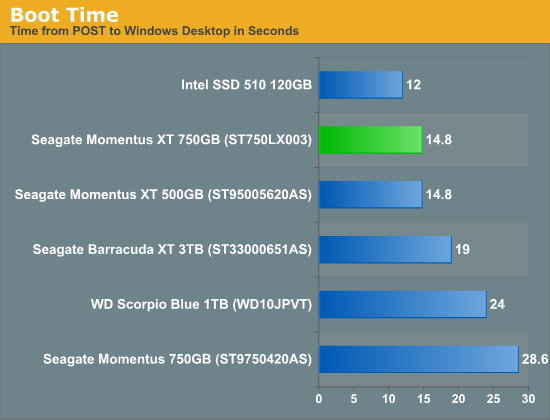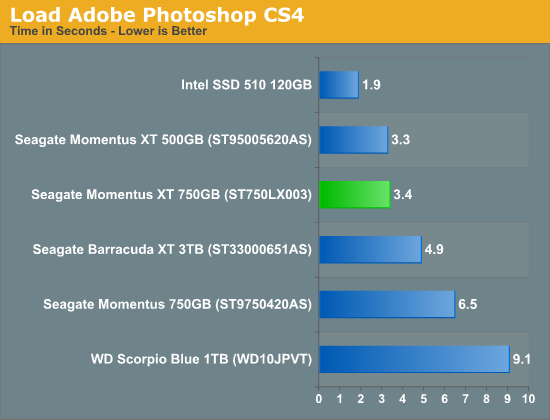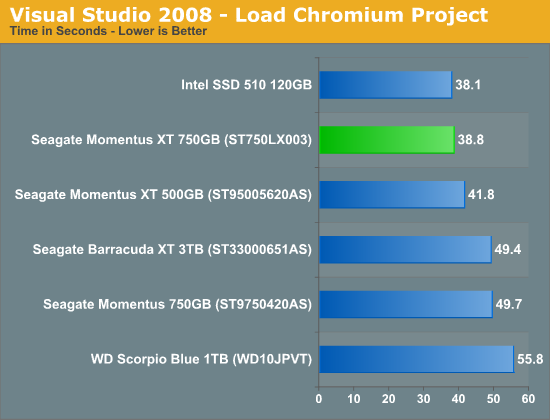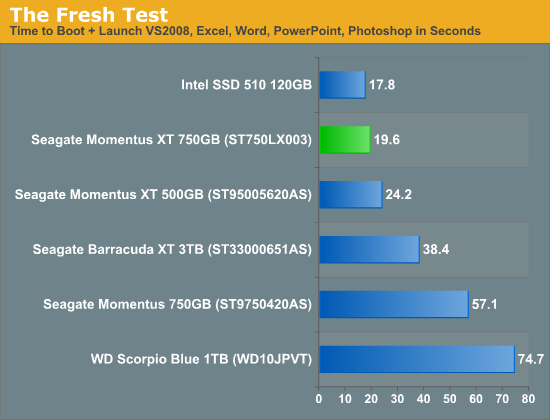Seagate 2nd Generation Momentus XT (750GB) Hybrid HDD Review
by Anand Lal Shimpi on December 13, 2011 12:51 AM EST- Posted in
- Storage
- Seagate
- Momentus XT
- Hybrid Drive
- HDDs
- SSHDs
Once More, With Feeling
Just as we did in our original Momentus XT review, we'll start with a look at some hand-timed application tests.
First up is a good old fashioned boot test. I measured boot time on our testbed from POST to first seeing the mouse cursor on the Windows 7 desktop. This isn't a timing of actual boot-to-use since more loading happens even after you get to the desktop, but it does encapsulate much of the Windows 7 boot process.
All tests were repeated until performance leveled off. In the case of an SSD, this was after just one run. In the case of the 500GB Momentus XT, it took five runs to get there, whereas the second generation model was there after just two. The traditional hard drives each took a few runs for their performance to stabilize as well due to Windows 7's own boot optimizations taking effect.

Boot performance continues to be very impressive on the Momentus XT. It's still not quite as fast as a high end SSD, but it's definitely faster than a traditional hard drive (even a faster, 3.5" model). With a larger NAND cache, your boot time is more likely to remain this low even as other applications and data are pulled into the cache.
Next let's look at a simple application launch test. Adobe Photoshop continues to be one of the more stressful workloads for a hard drive, even down to launching the application. Here I measured from the time I clicked on the Photoshop icon in the Start Menu to first appearance of the blank Photoshop canvas and toolbars. Again, I repeated this test until performance leveled off in all cases.
For the Momentus XT performance fluctuated and it never truly settled on a single launch time. Performance started out at over 5.6 seconds but for all runs after the 2nd launch time ranged in the upper 2s - upper 3s. For its results as well as those from all of the hard drives, I averaged five launch times and presented those averages. The lone SSD in this comparison delivered consistent performance across all runs.

Here the Momentus XT continues to do very well, for a hard drive. It's faster than any of our mechanical drives, and significantly faster than your run-of-the-mill 5400RPM 2.5" drive for sure. A good SSD is still around 70% faster than the Momentus XT.
When constructing our Visual Studio 2008 project build benchmark for our CPU reviews I was reminded just how much of a pain it is to do development work on a system with a hard drive. I tried using the same benchmark to measure drive performance however it seems I used too good of a CPU benchmark as disk performance plays a small role in actual compile time here. Instead I looked at the impact of disk performance on loading the Chromium project in VS2008. I used the same test rules as before, presenting performance once it has leveled off for all drives involved. Once again, the SSD delivered peak performance after a single run. The Momentus XT was able to do it after 2 - 3 runs. Performance didn't improve over multiple runs with the traditional hard drives.

There's a clear division between the NAND equipped Momentus XTs and the traditional hard drives here, but not so much between the former and the Intel SSD 510. I can definitely understand Seagate's temptation to draw the comparison to the performance of an SSD. The problem with doing this is highlighted in my comments above however. While the SSD always performed to the best of its abilities in our tests, regardless of the number of times I ran a test, the Momentus XT needed a couple of runs to get to that point. The NAND cache isn't overly predictive and as a result the first time you do almost anything the Momentus XT will perform like a traditional 7200RPM 2.5" hard drive. Given a light enough workload, the Momentus XT should be able to eventually fit much of the most frequently read data into its cache, but the process of actually getting there can still be painful.
For our last application level benchmark I turn to something I've used since the early days of SSD reviews: the fresh test. Take our boot test from earlier, and string together a series of application launches after you hit the desktop. In this case I'm launching Excel 2007, PowerPoint 2007, Word 2007, Visual Studio 2008 and Photoshop CS4 as soon as the system boots. I measure the time from POST until the last application is completely launched. I call this the fresh test because when you first build a machine everything, even on a traditional hard drive, performs quickly. Load up a lot of applications and use your system for a while and you'll soon notice that things aren't quite as snappy any more. Defragmenting your drive can help but after a certain point it's the bloat of everything installed that really limits performance. A better test would be to use an image that was months (if not years) old, but I've found that this benchmark gets the job done. Lower numbers here translate very well to a snappier system and one that feels new regardless of what you've got loaded on it. SSDs truly excel in the fresh test, but what about the Momentus XT?

Surprisingly enough, the Momentus XT does extremely well. The newer model clearly does a better job of keeping more data in NAND, but both are head and shoulders above the traditional hard drives. If you have a fairly regular usage pattern (E.g. you always run the same 5 or 6 applications), the Momentus XT can significantly improve the overall user experience. In some cases, it can even approach the performance of an SSD.










98 Comments
View All Comments
Anand Lal Shimpi - Tuesday, December 13, 2011 - link
According to Seagate the drive is still 9.5mm thick, just like the non-caching Momentus drive. I took a pair of calipers to the drive as well as a regular Momentus and both came up at just under 9.5mm (although my calipers aren't the super accurate variety, there could be some play in the numbers there). Do you have a reference to the 9.7mm figure?Still digging into FAST boot. If it works the way I think it works, it should be able to cache boot data from multiple OSes. Will find out for sure soon...
Take care,
Anand
Anand Lal Shimpi - Thursday, December 15, 2011 - link
Seagate provided a response to your second question:"The Momentus XT will learn multiple boot activities and retain the boot information for them in the boot partition. There should be no problem optimizing 2 or 3 different boot scenarios, but more than that may degrade the performance of the last first boot activity learned."
It's my understanding that it's not too hard to determine when a system is booting, the access pattern is fairly unique. The boot optimization simply looks for that pattern and has a small amount of NAND set aside for data that fits that pattern. Multiple OSes should trigger the optimization, but once you get beyond a certain threshold you do risk evicting useful data from the cache.
Take care,
Anand
b_flat - Tuesday, December 13, 2011 - link
No mention of the reliability?Head to the Seagate Forums or visit Amazon.com to see a list of continual problems with this drive
b_flat - Tuesday, December 13, 2011 - link
Amazon.comhttp://www.amazon.com/Seagate-Momentus-Solid-Hybri...
Seagate Forums
http://forums.seagate.com/t5/Momentus-XT-Momentus-...
Anand Lal Shimpi - Tuesday, December 13, 2011 - link
I mentioned the reliability issues in the video but I've added them to the conclusion as well. For what it's worth, both the old and the new Momentus XT have done well in my testbeds but as we've seen with SSDs in the past, that doesn't mean much.Take care,
Anand
Jonijc - Tuesday, December 13, 2011 - link
Hmmm....I only 5 star reviews on the new one: http://www.amazon.com/Seagate-Momentus-7200RPM-Hyb...
And 4 stars on the 500GB older one.
http://www.amazon.com/Seagate-Momentus-Solid-Hybri...
j
kmmatney - Tuesday, December 13, 2011 - link
I've had a 500GB XT drive for about a year - working great in a desktop computer. The $99 price seems like a steal now.applestooranges - Tuesday, December 13, 2011 - link
C'mon, the first Seagate Hybrid (released over a year ago?) was pretty much a joke, barely better than a normal 7200 rpm HDD. Anybody/everybody in the know could see this, but it somehow got praise from certain reviewers. Now, they release basically the same "non-innovative" and "non-effective" design, and it somehow gets a passing grade?50% better than nothing is still nothing.
I could spend half this much on an OCZ cache drive + a 1 TB HDD, and get twice (or 3x) the performance and more capacity.
these HDD guys just don't get it... how many years will it take them...
Anand Lal Shimpi - Tuesday, December 13, 2011 - link
I wouldn't say it's barely better than a normal 7200RPM hard drive, our numbers alone prove that's the case. As I mentioned in the conclusion however, my preference is still for an SSD + hard drive where possible. The Momentus XT really addresses the niche where you can only have one 2.5" drive and you need more capacity than an SSD can offer for whatever reason. In that case it does a decent enough job, but even then my preference would be for an internal SSD + external mass storage.Take care,
Anand
JNo - Tuesday, December 13, 2011 - link
Hi,don't often comment but really want to mention some possibilities that many seem to lack awareness of.
Firstly, I've read no mention, let alone review, of OCZ's Synapse Cache SSD on anandtech or of the NVELO dataplex software that drives it. It allows an entire SSD to cache an HDD but seems better than Intel SRT to me as faster and fewer limitations (no need for Z68 mobo, no SSD size limits). You can almost get a 3TB HDD to bench close to SSD speeds. I think they're looking to release the software one day too so you won't even need the proprietary OCZ SSD. Reviews:
http://www.storagereview.com/ocz_synapse_cache_ssd...
http://www.storagereview.com/nvelo_drives_storage_...
Secondly, you can get cheap optical drive bay HDD adaptor for laptops nowadays (ebay) so you can slot a second SSD/HDD where the optical was. This allows classic boot SSD + data HDD combo in laptops without mSATA. In fact it's a reason for me to look for lappies *with* an optical drive even though I'd otherwise prefer not to have one. Obviously this solution won't work for ultrabooks etc but still much more preferable to the Seagate Momentus for me.